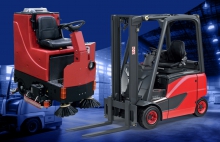Tuesday, January 05, 2010 By Patrick PenfieldWhitman School of Management, Syracuse UniversityPcpenfie@syr.edu W...
Tuesday, January 05, 2010
By Patrick Penfield
Whitman School of Management, Syracuse University
Pcpenfie@syr.edu
When we go to work, let’s face it: the last thing on our mind is getting injured or even dying. Unfortunately the United States Occupational Safety and Health Administration (OSHA) reported that in 2008, 5,071 workers died on the job. That’s an alarming number!
The United States Bureau of Labor Statistics (BLS) states that the number of nonfatal occupational injuries and illnesses reported in 2008 was 3.7 million cases and that the total recordable case injury and illness incidence rate was highest in 2008 among mid-size private industry establishments (those employing between 50 and 249 workers).
BLS also reports that about one-fourth of all occupational fatalities in 2008 involved workers in transportation and material moving occupations. Workman’s compensation is becoming a major expense for many companies. Why are employees dying or getting hurt on the job? How can we prevent these injuries from occurring? Is ergonomics the solution to these problems?
What is ergonomics?
Ergonomics is defined by the Merriam Webster dictionary as “an applied science concerned with designing and arranging things people use so that the people and things interact most efficiently and safely.” Simply put, it’s making sure that people are safe and are using the right equipment for the job at hand which will prevent them from getting hurt. The BLS states that sprains and strains were the most frequent nature of injuries and that the part of the body most often affected by work injuries is the trunk (including the shoulder and back) which accounted for 33 percent of all injuries.
What ergonomic equipment is in the marketplace today to prevent injuries? There are many different types of ergonomic equipment in use. Common pieces of equipment seen in industry would be lift tables, cranes, ergonomic shelving and equipment, adjustable platforms and workbenches. Most of this equipment prevents sprains and strains and also alleviate injuries to the trunk. Ideally we want to handle material without over-exerting ourselves, bending or twisting.
Resources for ergonomic information
The Material Handling Industry of America (MHIA) has an Industry Group called Ergonomic Assist Systems and Equipment (EASE) which is devoted specifically to ergonomics. EASE is a great resource for information on ergonomics and improving the working interface between people and the materials they move and use to reduce injury and increase productivity while providing a significant return on investment. EASE members review, discuss and revise the standards for the mechanical, structural and electrical design of ergonomic equipment, and formulates guidelines for the proper use, operation and maintenance of that equipment. For more information about EASE, visit www.mhia.org/EASE.
Learning about the importance and benefits of ergonomics in the workplace is the first step to improvement. Several outstanding resources are available through the MHIA bookstore at www.mhia.org/bookstore. One such book, Ergonomic Guidelines for Material Handling, is full of information on how to lift and employ ergonomic devices in the workplace. Another is Application Guidelines for Ergonomic Assistance and Safety Equipment which discusses all the ergonomic equipment needed based on the ergonomic motion classifications within your business (moving product to the worker or moving the worker to the product). Other titles are available, many of which are offered as free downloads.
In addition to books and guides, ergonomic training can be helpful. OSHA provides a great source for Web-based ergonomic training called e-Tools. OSHA e-Tools are interactive, Web-based training tools on occupational safety and health topics. They are highly illustrated and utilize graphical menus (www.osha.gov/dts/osta/oshasoft/index.html).
Ergonomics in the workplace
To implement a new ergonomics program in the workplace, it is best to establish a cross functional ergonomic committee with the support and blessing of top management. This group would be tasked with developing a plan for implementing an ergonomic program within the company. This team would create a mission statement, goals and objectives and budget.
The team’s first course of action is to understand the company’s ergonomic condition and to analyze the workplace environment. The team should review accident and incident reports and determine through a pareto analysis (a method of organizing problems from highest to lowest occurrence) the most significant ergonomic issues within the company. The highest ranking issue(s) should be where the group focuses its energies and efforts in the beginning of this program. Once problems have been identified, the team should determine what safety equipment or process improvements would eliminate or prevent these problems from occurring now as well as in the future.
Next, the committee should implement an ergonomic training program within the company. This may include the development of monthly training sessions for employees on specific ergonomic topics, such as teaching employees proper lifting techniques, how to avoid common ergonomic situations, correct form and posture when lifting material, and exercises to be performed on a daily basis to prevent injuries. All new employees should be given an orientation on ergonomics. The importance of safety should be emphasized and employees should also be given an outlet and process to report unsafe conditions and/or make suggestions fro improvements.
Finally, an audit process must be developed to review the work environment on a regular basis. Each month, the committee should track workplace injuries and incidents to determine root causes. Solutions should be determined and implemented as soon as possible, keeping in mind that any physical changes to the facility or to practices should be thoroughly examined and audited prior to execution to ensure that work conditions are safe.
Ergonomics should be an integral part of a company’s business plan. Addressing workforce ergonomic issues before they occur will improve morale and safety. An initial investment in ergonomic equipment and training may prevent serious issues and workman’s compensation claims from happening in the future. The key to running an effective ergonomic’s program is to consistently educate employees about the importance of safety and ergonomics, monitor the work environment, and remain attentive – especially when there are changes within your company.
In today’s world all workers should be protected from injury in the workplace. Ergonomics is an advisable, as well as a potentially profitable business practice.















 粤公网安备 44010602003952号
粤公网安备 44010602003952号